Order Information
This chapter covers the following topics:
- Order Information
- Purchase Orders
- Viewing Purchase Orders
- Printing Purchase Orders
- Acknowledging Purchase Orders
- Submitting Change Requests
- Splitting Shipments and Pay Items
- Using Work Confirmations (Complex-Work Purchase Orders Only)
- Canceling Orders or Shipments
- Managing Deliverables
- Work Orders
- Agreements
- Purchase Order Revision History
- Requests For Quotes (RFQ)
- Viewing Time Cards
Order Information
The real-time data provided in Oracle iSupplier Portal allows you to communicate procure-to-pay information with the buying company while viewing the purchase order flow.
Using purchase order information, you can acknowledge purchase orders, make change requests to purchase orders, split shipments, or cancel orders. You can also view supplier agreements and the revision history of a purchasing document.
This section includes the following topics:
Purchase Orders
When your buying company enters a purchase order in Oracle Purchasing, the purchase order details are available to you in Oracle iSupplier Portal. The View Purchase Orders page display the most recent 25 purchase orders (use the Previous and Next links to view additional purchase orders). Oracle iSupplier Portal enables you to track your purchase orders throughout the entire procure-to-pay flow.
The purchase order section includes:
-
Note: For the pages mentioned in this chapter, you may view details to various attributes by clicking the link associated with that attribute.
Accessing purchasing orders:
The View Purchase Orders page is the central page from which you access and process your purchase orders.
To access a purchase order for further processing:
-
From the iSupplier Portal Home
page, click the Orders tab.
-
From the View menu, choose which purchase orders to display:
-
All Purchase Orders
-
Purchase Orders to Acknowledge
-
Purchase Orders Pending Change
An advanced search facility is available to refine your search even further. You also have the option to export the displayed data.
-
On the resulting View Purchase Orders page, select the purchase order you wish to process:
-
To acknowledge a purchase order, click Acknowledge
-
To submit a change request click Request Changes.
-
To view purchase order changes,click View Change History.
Viewing Purchase Orders
Supplier Brokers have access to information about multiple suppliers, therefore a search filter for transaction documents is enabled for all supplier broker logins. This allows supplier brokers to search for, and filter required data only.
If you have logged in as a supplier broker, then this page displays the Supplier drop-down, the Supplier Site field, and the View drop-down. Select a supplier from the list. This is a mandatory field. The Supplier Site field is optional. The View drop-down enables you limit your view to all purchase orders, purchase orders to acknowledge, or purchase orders pending supplier change.
Viewing Order Details
You can view details of a purchase order such as terms and conditions, lines, shipments, and attachments from the Purchase Order Details page.
To view the details of a purchase order:
-
Access the purchase order you want to view by clicking its purchase order number .
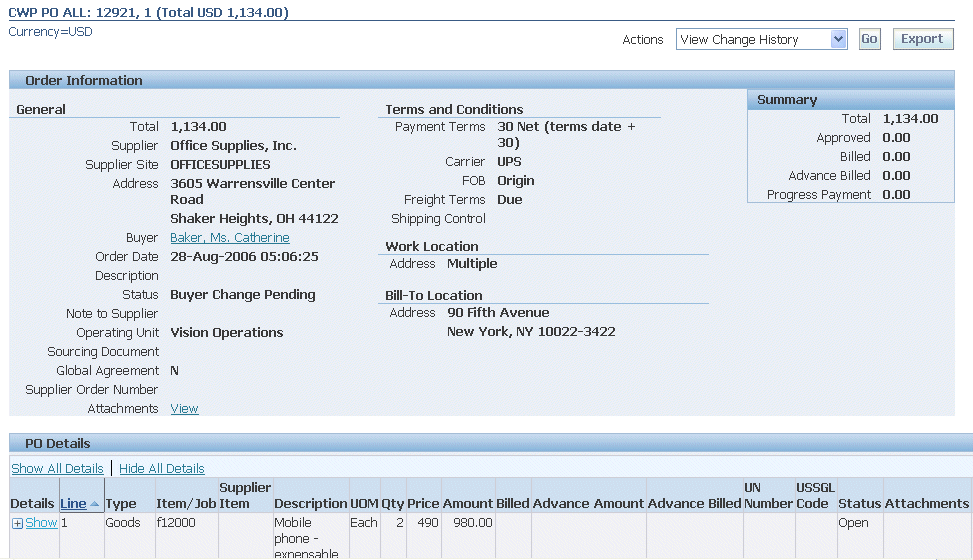
The View Order Details page shows you detailed information about the purchase order, including both header and line information. The Order Information section shows general information, terms and conditions, ship-to (non-complex work purchase orders), work location (for complex-work purchase orders) and bill-to information.
The Linked Attributes column in the PO Details region has a Linked Attributes link. Click this link to view the attributes associated to the Job - Purchasing Category - Shopping Category combination. External descriptors that are associated to the Job – Purchasing Category – Shopping Category combination are displayed along with the job or item related details. Internal descriptors are not seen by suppliers at all, they are visible to buyers only
In the Summary container, you can view the:
-
Total - amount of the total purchase order.
-
Received - amount for the items of the purchase order that have been received.
-
Invoiced amount - amount for the items on the purchase order that have been invoiced.
-
Payment status - status of the invoices against the PO.
By selecting options from the Actions menu, you can:
-
Request changes. See Submitting Change Requests for more information.
-
Cancel the purchase order.
-
View the change history for this purchase order. See Purchase Order Revision History for more information.
-
View work orders. See Work Orders for more information.
-
Print the purchase order. See Printing Purchase Orders for more information.
-
View related contracts. The View Related Contracts page for a purchase order displays the summary of the approved or signed related contracts associated with the purchase order. Use this action to track or view related contracts such as master agreements and umbrella agreements. You can view only contracts related to the organizations to which you have access.
-
Create a work confirmation (complex-work purchase orders only).
-
View work confirmations (complex-work purchase orders only).
-
View current receipts.
-
View current invoices.
-
View current payment status.
-
View current shipment status.
Line Information

Viewing Order Details (Complex Work)
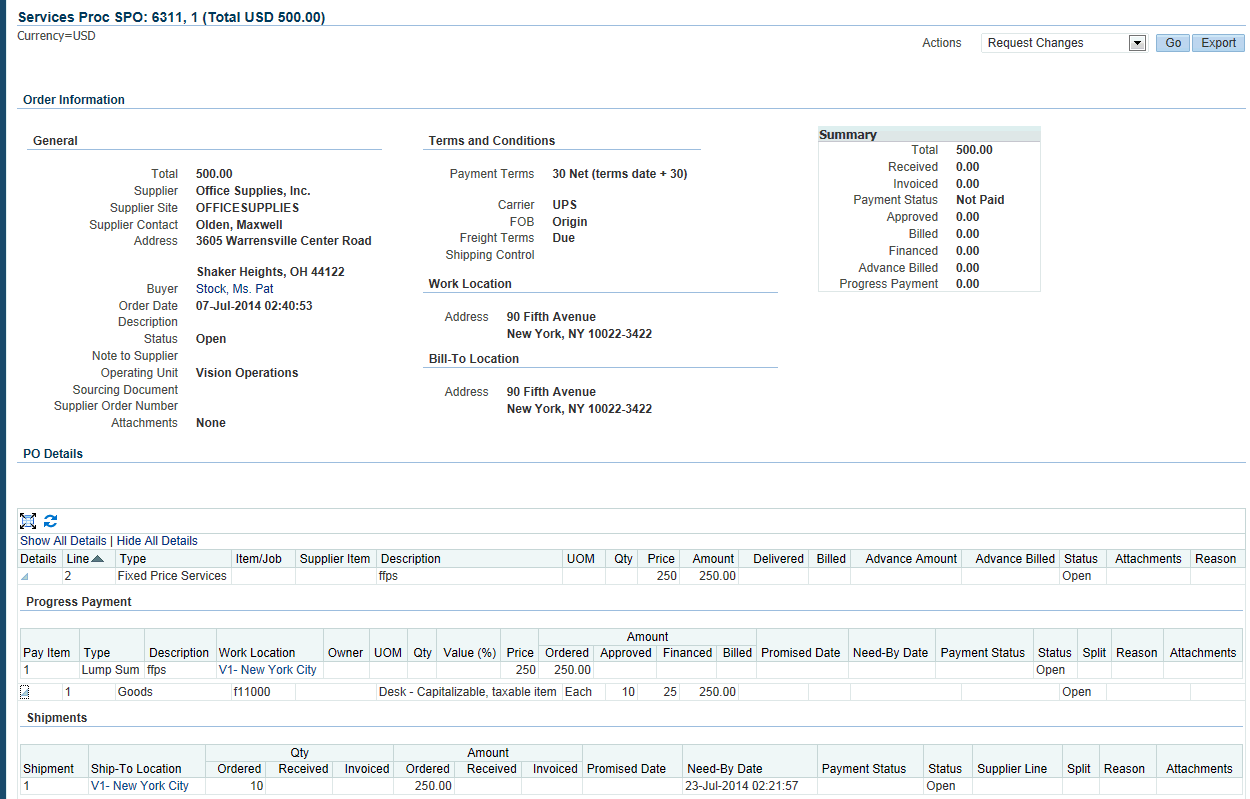
The Summary container on the View Details page for a complex work PO displays different information.
-
Approved amount - total approved amount of work confirmations against the PO.
-
Financed amount - total pay item amounts financed plus advanced billed.
-
Advanced billed amount - total advance amounts billed at the line level.
-
Progress payment - total amount financed or billed of all pay items.
-
Delivered - amount of the delivery shipment approved through the work confirmation. Delivery shipments are created for orders where progress payments are considered contract financing. This field is hidden by default.
-
Recouped - amount of advances and pay items recouped to date. This field is hidden by default.
-
Retained - amount of pay items retained to date. This field is hidden by default.
The Actions menu options include:
-
Request changes.
-
Cancel the purchase order.
-
View the change history for this purchase order.
-
Print the purchase order.
-
Create a work confirmation.
-
View work confirmations.
-
View current receipts.
-
View current invoices.
-
View current payment status.
The PO Details sections shows line specific information. Click Show to see the receiving, invoicing and payment information for a particular line, or pay item information for a complex work line.
Line Information (Complex Work Line)

Printing Purchase Orders
You can view and print Portable Document Format (PDF) versions of purchasing documents, including blanket agreements. If your buying company has implemented Oracle Procurement Contracts, you can also print the contract terms or clauses that the buying company has defined on the purchasing documents.
To print purchase orders:
-
Access the purchase order.
-
Select View PDF from the Actions menu, and click Go..
-
On the prompt window, you can choose to open the document immediately, or save it locally for later printing.
Acknowledging Purchase Orders
When creating a purchase order, buying companies can request acknowledgment of the purchase order. If so, you as a supplier will receive a notification requiring your response. The purchase order may include a date by which you need to acknowledge or sign it.
You acknowledge purchase orders to communicate to the buying company that you have received, reviewed the details of, and accepted or rejected a purchase order. You cannot communicate changes to the purchase order during acknowledgment. To communicate changes, click the Request Changes button in the Purchase Orders Summary page or select the Request Changes action from the Actions dropdown in the Purchase Orders Details page.
If you have logged in as a supplier broker, use the actions in the preceding paragraphs (as a supplier would use) to acknowledge purchase orders.
The Reject Entire Order action is made available by the buyer using responsibility functions. Using the Reject Entire Order action, you can let the buyer know if you are unable to fulfill any part of the purchase order.
If you have logged in as a supplier broker, you can reject the entire order. Use the Reject Entire Order action to communicate the rejection to the buyer.
You can either acknowledge the order online, or accept or reject the order using the notification. The notification does not allow shipment level acknowledgment, which must be entered online. When you respond, the purchase order is automatically updated, and a notice is sent to the buyer.
You can submit acknowledgments for an entire order, or for individual shipments. For example, if you can fulfill only part of a purchase order, accept the shipments you can fulfill, and reject the others (note that shipment level acknowledgement cannot be performed using the acknowledgement notification).
When the supplier clicks the Save button, the order will be saved in an intermittent state and supplier can work on the order later.
Suppliers can save orders without needing to select an action from the Actions dropdown for all shipments.
Later when a supplier returns to this order, the supplier can modify all the responses that have been entered earlier for the shipments, and also enter responses for those shipments which were not acknowledged in earlier rounds.
Please note that the buyer will not be able to take any action on an order that has been saved by the supplier unless the supplier submits it.
If the order is set to be acknowledged at the document and shipment levels, you cannot indicate change requests during acknowledgment.
For complex work purchase orders, you can acknowledge pay items.
Note: The value of the need-by date is defaulted to the promised date field on supplier acceptance in the acknowledgment process.
To acknowledge purchase orders:
-
Access the purchase order you wish to acknowledge.
Acknowledge Purchase Order Page
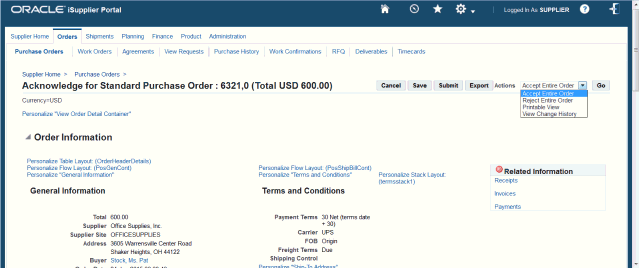
-
On the Acknowledge page, you can accept or reject an entire order, or you can accept or reject individual shipments.
-
To accept/reject an individual line's shipment or pay item, click Show for the line.
Acknowledging Shipments and Pay Items
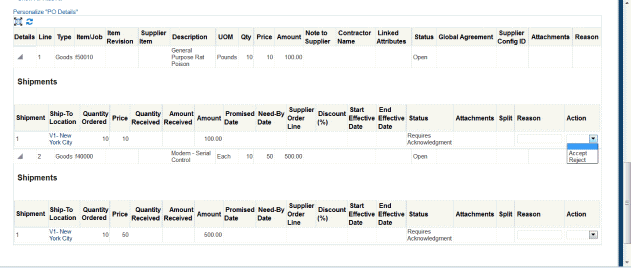
-
For the shipment/pay item, select Accept or Reject from the Action menu. If rejecting a shipment or pay item, provide a reason.
-
Click Submit.
Acknowledging pay items
If the terms for a complex-work purchase order terms require "document or shipment" acknowledgement, you can accept/reject at the pay item level. To accept/reject an individual pay item, click Show for that line. Select Accept or Reject from the Action menu at the end of the line (if you reject the pay item, you must also provide a reason). If you either accept or reject all the pay items, the purchase order status changes to "acknowledged."
Pay item changes are immediately submitted to the buyer for acknowledgement even if the rest of the order is only partially acknowledged. If the buyer rejects the change, the purchase order status reverts back to "Requires Acknowledgement."
Suppliers can:
-
Accept or reject the purchase order at document level that has lines with pay items as well as with shipments.
-
Accept or reject an individual pay item or schedule in a purchase order document.
-
Acknowledge pay items and schedules.
Signing Purchase Orders
If your buying company has implemented Oracle Procurement Contracts, your buyer may ask that you electronically sign a purchasing document while acknowledging it. Legally binding purchasing documents must be signed by both the buyer and supplier.
After you sign the document, your buyer will be notified. The purchase order will be ready for execution after both the buyer and supplier have electronically signed the purchasing document.
Note: If your buyer asks that you electronically sign a purchasing document, you cannot respond at a specific shipment level, you have to accept or reject the entire order.
To sign a purchase order:
-
Click the Orders tab, and then click Purchase Orders in the task bar below the tabs.
-
Search for and select the purchase order with a status of Requires Signature, and then click Acknowledge.
Purchase Order Signature Page
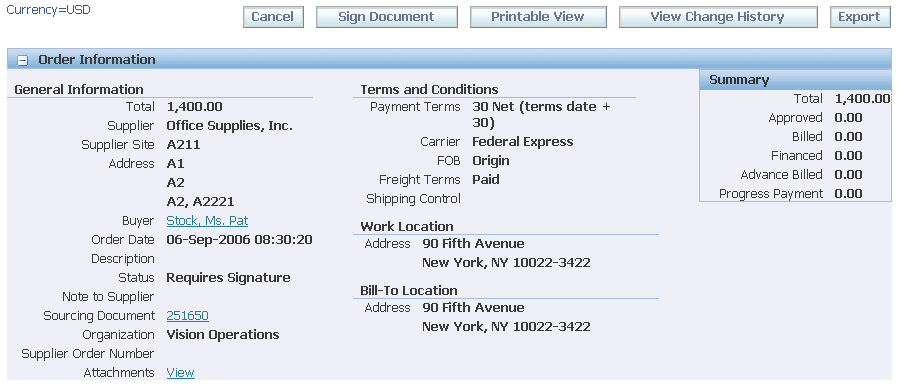
-
On the Acknowledge page, click Sign Document.
Sign Document Page

-
Click any attachments you would like to view to review the attachments for terms and conditions.
-
Click Accept or Reject.
Sign Document Page

-
On the Notification Signing page, enter your username and password and click Submit.
-
You will receive confirmation that your purchase order has been acknowledged.
Submitting Change Requests
Oracle iSupplier Portal enables you to request changes to purchase orders when modifications are needed to fulfill an order. You can make changes before and after acknowledgment. You can change a single purchase order, or, depending on the change you need to make, you can update multiple change orders at the same time.
If you have logged in as a supplier broker, you can submit a single change request only. Use the steps in the following paragraphs to submit a single change request.
To submit a single change request:
-
Click the Orders tab, and then click Purchase Orders in the task bar below the tabs.
-
On the View Purchase Orders page, search for and select the purchase order for which you wish to request changes.
-
Select the purchase order and Click Request Changes.
-
On the Request Changes page, enter your changes.
Request Changes for Standard Purchase Order
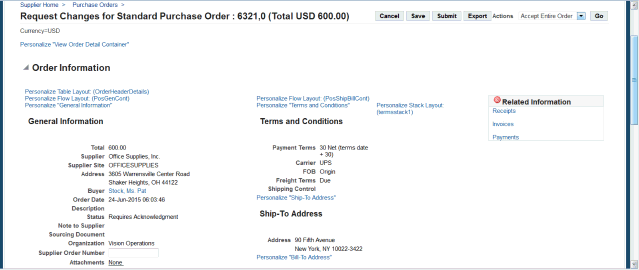

-
You may request changes to the following values :
-
Price/Price Breaks on Blanket Agreements
-
Supplier Item
-
Supplier Order Reference Number
-
-
In the reason text box, enter a reason for your change request.
-
If you wish to request changes to shipments or pay items, click Show. You can request changes to
-
Price/Price Breaks on Blanket Agreements
-
Quantity Ordered
-
Promised Date
-
Supplier Order Line
-
Note that you can also enter change request information in the Additional Change Request text box.
-
-
Enter the changed values as appropriate.
-
Enter a reason for your change.
-
Select the appropriate action.
-
Click Submit.
The supplier can submit an order without selecting an action (or providing acknowledgement) for all the shipments. In such a case the supplier is supposed to provide acknowledgement for all the shipments for which he either requested change or did not select any value for, once the buyer has provided his response on the change request.
Example: An order that consists of a line and four shipments was sent to a supplier for acknowledgement. The supplier performs the following action before submitting the change request:
-
1st shipment – Accepted
-
2nd shipment – Change
-
3rd shipment – Rejected
-
4th shipment – No value selected
On receiving this request, the buyer approved all the changes. The purchase order was sent again to the supplier for acknowledgement.
The supplier acknowledged shipment numbers 2 and 4. The supplier could not change the shipment number 1 and 3 because his decision (Accepted and Rejected) were final for those shipments. The shipments 1 and 3 were displayed to the supplier in read-only mode.
When the supplier provided his acknowledgement (Accept/Reject) for all the shipments and submitted the order, only then the order was considered to be completely acknowledged.
When the supplier clicks the Save button, the order is saved in an intermittent state and supplier is allowed to work on it later. The supplier can save an order without selecting a value in the Actions dropdown for all the shipments.
Later when the supplier returns to this order to work on it, he can modify all the responses that he has entered earlier for the shipments, and also to enter the response for those shipments which he didn't acknowledge/change the previous time.
Please note that buyer cannot take any action on an order that has been saved by the supplier, until the supplier submits the order.
Submitting change requests for complex-work purchase orders
Request Changes for Complex-Work Purchase Order
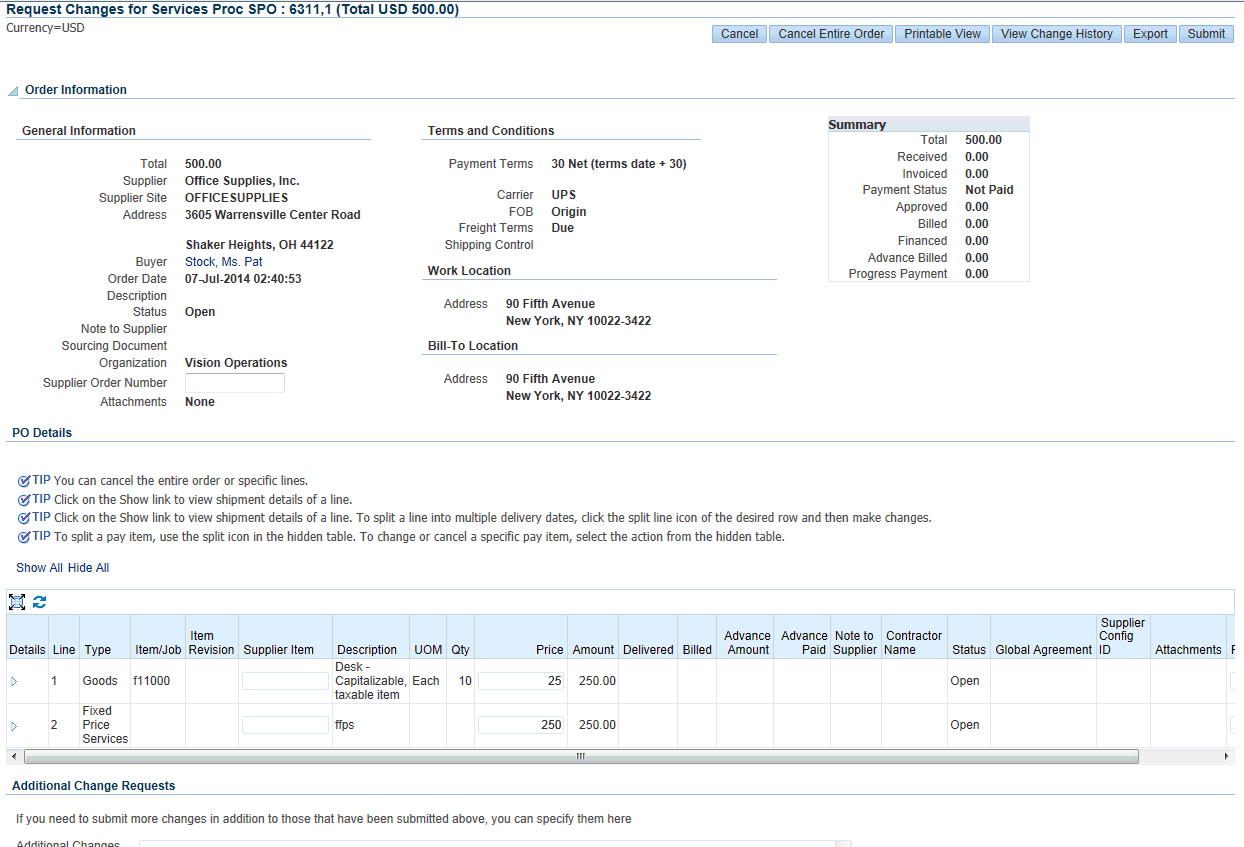
If Oracle Services Procurement is licensed and implemented, then a supplier can submit the following change requests for order documents for which Progress Payments and Schedules are enabled:
-
Request changes to goods with milestones for the order document that has lines with pay items.
-
Request changes to services with milestones or lump sum for the order document that has lines with pay items.
-
Request changes to services with rate based milestone for the order document that has lines with pay items.
-
Request changes to Ordered Quantity for the Order document that has lines with schedules.
-
Request changes to Need By date for the Order document that has lines with schedules.
-
Cancelling purchase order lines that have both pay item lines and shipment lines.
-
Canceling pay items and schedules.
-
Splitting of payment schedule.
-
Splitting shipment schedule.
-
View the changes and Change history.
Once the supplier submits the changes, the supplier user can view the latest approved revision of the purchase order. In addition, the supplier user can view details of the changes and the history of changes requested and the corresponding responses from both the supplier user and the buyer.
Changing complex-work purchase orders
If this is a complex-work purchase order you can only change the supplier item at the line level. If progress payments are treated as delivery, price updates are only allowed at the pay item level (any changes roll up to the line level). If pay items are considered contract financing, then price updates at both the line level and pay item level are allowed.
-
Price changes - For milestone and rate, price changes are not allowed if the pay item has been partially received or invoiced (that is, retroactive price changes are not allowed). For a lump sum, if the pay item has been partially received or invoiced, the new price should equal or greater than the amount received or invoiced to date.
Changes in price are prorated to the distributions if the shipment has multiple distributions. The buyer can change the distribution amounts during response.
-
Quantity changes -
Quantity changes are only allowed for Rate pay items. If the pay item has been partially received or invoiced, the new quantity should be greater than or equal to the larger of either the quantity received or the quantity invoiced. A change in quantity is prorated to distributions, if the pay item has multiple distributions. The buyer can enter new quantities when responding.
Note: After submitting your changes, the purchase order status changes to Supplier Changes Pending until the buyer approves the changes.
To update multiple purchase orders simultaneously:
Many times, you may need to make the same change to a group of purchase orders. Depending on the type of change you need to make, you may be able to update multiple purchase orders simultaneously. You can perform multiple changes to standard purchase orders, agreements, and releases.
For purchase order lines, you can change:
-
Unit Price (only for goods lines)
-
Supplier Part Number
For purchase order shipments, you can change:
-
Promised Date
-
Quantity Ordered (only for goods shipments)
-
Price (only for shipments with lines where value basis is fixed price).
To update multiple purchase orders:
-
On the Purchase Orders page, click Multiple PO Change.
Multiple Purchase Order Changes
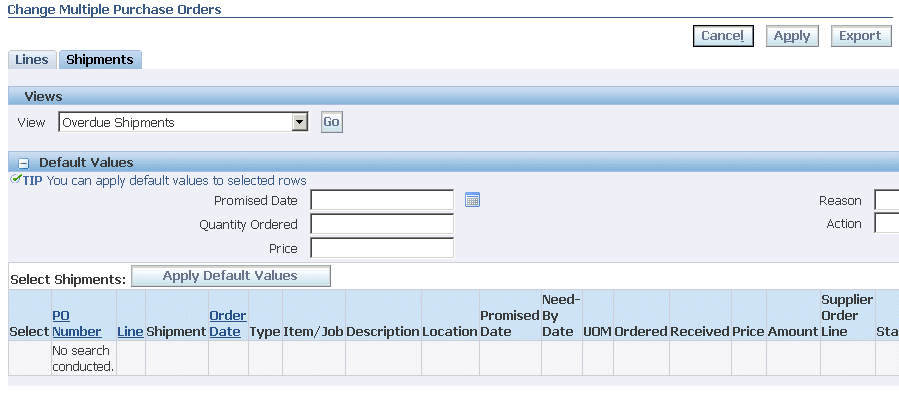
-
You can search for shipments to acknowledge or change by selecting
-
Overdue Shipments
-
Shipments Dues in One Week
-
Shipments Requiring Acknowledgments
-
All Shipments
from the View menu and clicking Go.
-
-
You search for a group of purchase orders, click the Lines tab and use the advanced search option to identify the group of purchase orders you wish to change.
Multiple Purchase Order Change Page
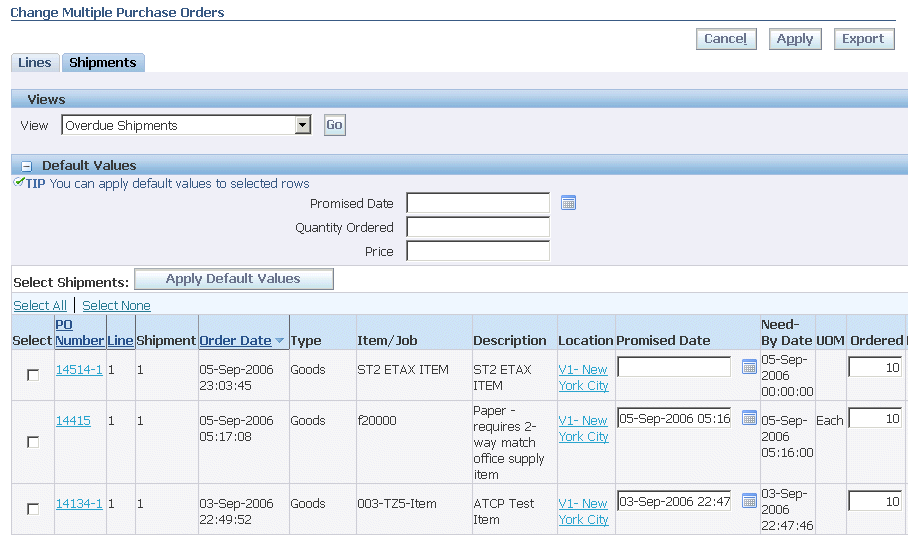
-
If you wish to change the same attribute for multiple purchase orders to the same value,
-
Enter the new value in the Default Value field.
-
Select the appropriate purchase orders.
-
Click Apply Default Values.
-
-
If you wish to update multiple purchase order attributes to different values, enter the new values directly into the fields in the Lines table.
-
Enter a short text explanation for the change in the Reason field.
-
Click Apply.
Change Requests for Services
Suppliers can request changes to the price for service lines and create new service schedules by splitting an existing schedule.
To view change order history:
This view enables you to view the history of change requests submitted on a document, and the corresponding buyer response.
-
Click the Orders tab, and then click Purchase Orders in the task bar below the tabs.
-
Search for and select a purchase order, and then click View Change History.
-
View the change order history details on the PO Change Order History page.
Note: If Oracle Services Procurement is licensed and implemented, then when the order document has both “Schedules” and “Progress Payments” enabled, the column name “Pay item” in the multiline changes to “Schedule/Pay item”.
PO Change History Page

-
Click OK to return to the Purchase Orders page.
Statuses for Acknowledgment and Change Request processes
The following table outlines the statuses for the Acknowledgement and Change Request processes for both the buyer and the supplier:
| Action Taken | Supplier Status | Supplier Change Request Status | Buyer Status | Buyer Acknowledgment Status |
|---|---|---|---|---|
| PO Submitted (Supplier Acknowledgement required) | Requires Acknowledgement | - | Approved | Requires Acknowledgement |
| Supplier Saves Order | Requires Acknowledgement | Draft | Approved | Supplier Locked |
| Supplier Requests Change | Requires Acknowledgement | Changes Submitted | In Process | Requires Acknowledgement |
| Buyer Accepts All Changes | Requires Acknowledgement | - | Approved | Requires Acknowledgement |
| Buyer Rejects All Changes | Requires Acknowledgement | Changes Rejected | Approved | Requires Acknowledgement |
| Buyer Approves Few Changes | Requires Acknowledgement | - | Approved | Requires Acknowledgement |
| Supplier Accepts Entire Order | Accepted | - | Approved | Accepted |
| Supplier Rejects Entire Order | Rejected | - | Approved | Rejected |
| Supplier Acknowledges Complete Order (Accepts few shipments and Rejects others | Accepted | - | Approved | Acknowledged |
Changes to Shipments that have linked Drop Ship Lines
When you submit a change request for a drop ship purchase order shipment, where you need to update or change the Promised Date, the following validations occur in the system. A drop ship purchase order integrates with Oracle Order Management, thus the following validations take place:
-
When you make a change to the Promised Date and the change is within the Buyer Auto-Acceptance Tolerances set for Supplier Change Order, an Oracle Order Management API is called to validate if the requested changes can be allowed on the sales order. If the validations are successful, the change order request by the supplier is automatically approved and the modified Promised Date is updated as Scheduled Ship Date in the sales order. If the validations are not successful, the error message from the Oracle Order Management API is displayed in the Change Request page for the supplier to take corrective action.
-
When you make a change to the Promised Date, and the change is not within the Buyer Auto-Acceptance Tolerances set for Supplier Change Order (Setup > Tolerances and Routings > Supplier Change Order), an Oracle Order Management API is called to validate if the requested changes can be allowed on a sales order. If the validations are successful, the change order request by the supplier is routed to the buyer/requester for approval. When the buyer/requester accepts/rejects the changes from the workflow notification the following scenarios occur during the submission check of the purchase order:
-
An Oracle Order Management API is called and if all the validations are successful, the value of the updated Promised Date is carried over to the Scheduled Ship Date of the sales order.
-
If the call to the Oracle Order Management API is not successful, the error message from the Oracle Order Management API is displayed at the top of the notification.
-
-
When you make a change to the Promised Date, and the change is not within the Buyer Auto-Acceptance Tolerances set for Supplier Change Order, an Oracle Order Management API is called to validate if the requested changes can be allowed on a sales order. If the validations are successful, the change order request by the supplier is routed to the buyer for approval. When the buyer accepts/rejects the changes from the “Respond to Supplier changes” page the following scenarios occur during the submission check of the purchase order:
-
An Oracle Order Management API is called and if all the validations are successful, the value of the updated Promised Date is carried over to the Scheduled Ship Date of the sales order.
-
If the call to the Oracle Order Management API is not successful, the error message from the Oracle Order Management API is displayed in the page for the buyer to take corrective action.
-
Splitting Shipments and Pay Items
You can request to split a shipment. For example, if you can only partially ship the quantity ordered for the given date, you can enter a split shipment change request. This request will let the buyer know the number of items you can deliver and what date you will deliver them.
To request to split a shipment:
-
Click the Orders tab, and then click Purchase Orders in the task bar below the tabs.
-
Search for and select a purchase order, and then click Request Changes.
-
On the Request Changes page, click Show to display shipment details.
-
Click the split icon on the desired shipment line. (Another row is added for your split shipment).
Split Shipments Page

-
In the Quantity Ordered field of the first shipment line, enter a new quantity.
-
In the Quantity Ordered field of the second shipment line, enter the new quantity.
-
Change the Promised Date.
-
Enter the Supplier Order Line.
-
Enter a reason for splitting.
-
Select an action for change.
-
Click Submit.
Note: You can split a shipment as many times as needed. To create more shipment lines, click the split icon.
Splitting Pay Items for Complex Work Purchase Orders
The pay items for a complex-work purchase order are stored at the line details level the same way as shipment information. Therefore, you can use the instructions above to split an existing pay item to create a new payment schedule. A new pay item is created with a price of 0 and quantity or 0. You can modify the following fields:
-
Description
-
Price (if lump sum, the price on the original pay item should be greater than the larger of either the amount received or the amount invoiced).
-
Promised date.
Using Work Confirmations (Complex-Work Purchase Orders Only)
Over the course of a complex work project, various pay items defined for the contract come due. To notify a buyer that a pay item needs to be processed for a completed unit of work, you can create a work confirmation.
Note: If there are any pay items linked to receipt of materials, then you cannot create work confirmations for those as long as the material is not fully received. Work confirmation can be created for the pay items only if the schedules mapped to the pay item are fully received. You can select a pay item only when all the schedules mapped to the Pay item are in the Closed for Receiving or Cancelled status. You cannot create a work confirmation if any of the mapped schedules to the pay item are in the Frozen, Open, or Finally Closed status.
To search for existing work confirmations:
-
From the home page, click the Orders tab, and then click the Work Confirmation subtab. The Work Confirmations page displays with the views listed. You can search for your work confirmations by using the View drop-down and clicking Go.
-
Alternatively, you can search for your work confirmations by using the Advanced Search button. When you click the Advanced Search button, the Work Confirmations Advanced Search region displays. You could use the standard search criteria, or use the Add Another drop-down to search using additional search criteria, such as PO Number, Order Line Number, Work Confirmation, etc.
-
Supplier Brokers have access to information about multiple suppliers, therefore a search filter for transaction documents is enabled for all supplier broker logins. This allows supplier brokers to search for, and filter required data only.
If you have logged in as a supplier broker, this page displays Supplier drop-down, Supplier Site field, and the View drop-down. Select a Supplier from the drop-down, this is a mandatory field. The Supplier Site field is optional. The View drop-down enables you to select Last 25 Work Confirmations, Draft Work Confirmations, Rejected Work Confirmations, All Work Confirmations. This enables you to search for specific supplier information.
To create a work confirmation:
-
Access the purchase order.
-
On the PO Details page, select Create Work Confirmation from the Actions menu and click Go.
-
From the View menu, select either
-
Pay Items Due This Week
-
Pay Items Due This Month
-
All Pay Items
-
-
You can also enter and track the progress of the complex work using the following fields:
-
Previously Requested / Delivered
-
Previous Progress %
-
Current Requested / Delivered
-
Material Stored
Note: The Material Stored field allows the supplier to request a payment for material which has been purchased and stored on site for use. Using the work confirmation, the supplier can enter the requested amount based on work actually completed, and has an option for requesting payment for material purchased but not yet consumed in work.
-
Current Progress %
-
Total Requested / Delivered
-
Total Progress %
You can enter / update the values of the Current Progress % and Total Progress % fields, they will be recalculated.
-
-
Click Go.
-
On the Create Work Confirmation page, select one or more pay items and click Next.
Create Work Confirmation page
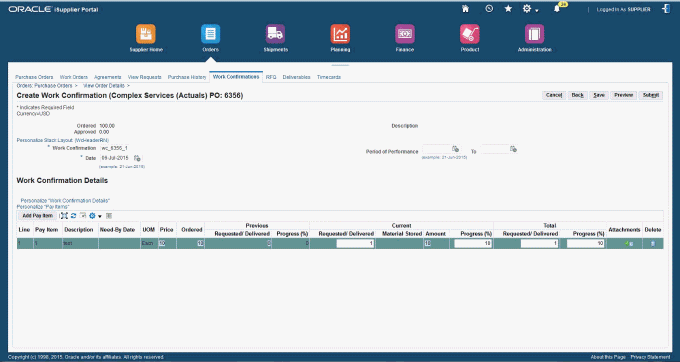
-
Enter a work confirmation ID.
-
Enter a request date for the work confirmation in the Date field. You can specify the request date as the current date or a past date, however, the date cannot be a future date.
Important: Your system administrator can define the POS: Use Approval Date for Work Confirmation Processing profile option to use the approval date for work confirmation processing instead of the submission date. For more information, see Oracle iSupplier Portal Implementation Guide.
-
If this work confirmation reflects a particular span of time, optionally enter performance period dates.
-
Accept the default or enter a value for Requested/Delivered. .
-
Update the Progress Percentage column, if appropriate.
-
Enter comments in the Comments text area. The comments specified at this header level are displayed as part of the notification to the approver.
You can enter comments for the work confirmation as a buyer, as a supplier or using the iSupplier Portal - Internal View responsibility.
-
Attachments added to the Complex Purchase Order at the pay item level are displayed to the buyer when work confirmations are created.
-
Click Save to keep a draft work confirmation in the system. You can return to the draft later for make further updates or submit it. When you have finished defining your work confirmation, click Submit. Once you click Submit, the approver is notified of the work confirmation and must approve it.
-
Internal users, buyers, or contractors can create work confirmation even if the complex purchase order transaction has a status Frozen, however suppliers cannot.
To view or update an existing work confirmation:
You can view existing work confirmations.
-
From the Orders tab, click the Work Confirmations subtab.
-
From the View menu, select either
-
Last 25 Work Confirmations
-
Draft Work Confirmations
-
Rejected Work Confirmations
-
All Work Confirmations
-
-
The search results show the progress of the complex work order using the following columns:
-
Previous Requested
-
Previous Delivered
-
Current Requested
-
Current Delivered
-
Total Progress %
-
-
Click the work confirmation number to access and view the work confirmation.
You can select the work confirmation and click Update if you need to make changes to confirmation or address any issues with a rejected confirmation. You can modify details of a rejected work confirmation as well as add additional items.
If the confirmation has a status of Processing, Rejected, or Pending Approval, then you can select the confirmation and delete it.
-
The supplier submits a work confirmation for approval, and the buyer rejects the work confirmation and adds header level comments stating the reason for rejection; these comments are visible to the supplier when the supplier updates the rejected work confirmation.
-
Buyers or other users using the iSupplier Portal – Internal View responsibility can use the action View Work Confirmation. The View Work Confirmation page displays the Approval History column. The Approval History icon, when clicked, displays the Approval History page that shows you the current and pending approvers. The Approval History icon does not display if the transaction has an error, or has a status of Draft or Processing.
The Approval History icon is shown to users only if the status of the work confirmation document is: Pending Approval, Error, Rejected, Approved, Processed, Processing Error, Cancelled and Corrected. This icon is not visible if the status of the work confirmation document is Draft or Processing.
The Approval History page has two regions:
The first region displays the Approvers sequenced in order according to the date and timestamp of when they took action regarding the notification. This section also displays the approved person and the date of approval along with comments.
The second region displays the current/pending approvers, the type of approvers and the approver with whom the document is pending.
-
Buyers or other users using the iSupplier Portal – Internal View responsibility can view the status column of the work confirmation documents.
The status column is displayed as a link only for Error and Processing Error statuses. The link opens the View Errors page (if the system captures any errors). For all other status of the work confirmation document, the status column does not have a link.
The View Errors page displays all the validation failures that are identified when running the Receiving Transaction Processor concurrent program. Internal users cannot perform any action, or take corrective actions using this page.
To correct an existing work confirmation:
You can correct existing work confirmations that are in the Processed or Approved status.
-
From the Orders tab, click the Work Confirmations subtab.
-
From the View menu, select the Work Confirmations I Have Approved option or the All my Work Confirmations option.
-
Click Go.
-
The search results show a list of work confirmations as per the option you select in step 2. Click the work confirmation number link of a work confirmation, with the status as processed or approved, to access the required work confirmation details.
-
Click the Correct button.
Work Confirmations page
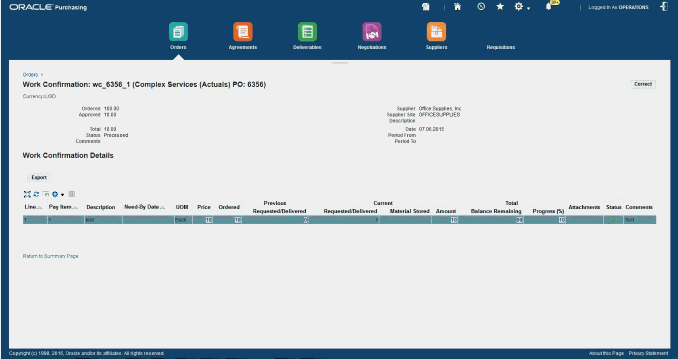
-
Enter the required correction. You can correct details such as the requested/delivered amount/quantity, Date, and the percentage of progress, under the Current and Total headers of the work confirmation.
-
Ensure that the value you enter in the Requested/Delivered or the Progress (%) field is lesser than the approved value.
-
Ensure that you enter appropriate comments in the Comments field for each pay item submitted for correction.
-
Ensure that you select the pay items for which you want to submit a correction by selecting the appropriate check box.
-
You can update or correct the request date as the current date or a past date, however, the date cannot be a future date or earlier than the receipt creation date. The system validates the date to ensure that it is in an open GL period and in open accounting / receiving periods if the date is updated.
Work Confirmation Correction Details page
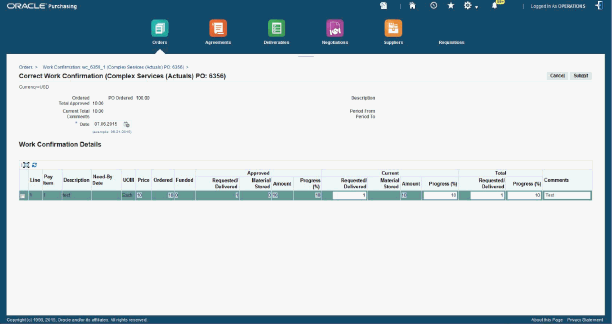
-
-
Click the Submit button.
-
You can verify the work confirmation correction after the status of the work confirmation changes to Corrected. You can view the correction details in the Work Confirmation Correction History region on the Work Confirmation Details window.
Using the Response Page for Complex Work Purchase Orders
For complex work purchase orders:
-
When the document style has both “Schedules” and “Progress Payments” enabled and if all the lines in the order document has “Schedule” related details then the header region caption displays “Ship-To Address” and “Bill To Address”
-
When the document style has both “Schedules” and “Progress Payments” enabled and if any of the lines in the order document has “Pay items” details then the header region caption displays “Work Location” instead of “Ship to Address” and “Bill To Location” instead of “Bill To Address”
-
When the Order document has both “Schedules” and “Progress Payments” enabled, then the column name “Pay item” in the changes to “Schedule/Pay item”.
Using AME for approving Work Confirmations
Depending on business requirements, administrators can set up approvers and reviewers in AME for work confirmation approval.
Organizations can use the predefined AME transaction type (WCAPPROVE) and Work Confirmation Approval workflow process on the supplied components and their business requirements.
Based on the setup, the Approvers region displays approvers, reviewers, and signers.
Creators of the work confirmation have the flexibility to send Work Confirmation documents to approvers based on the AME setup.
Approvers can edit Work Confirmation when they receive the approval notification.
Approvers can approve, approve and forward, reject, or reassign the Work Confirmation approval notification. They can add their comments to the notification page.
For information about AME, refer to the Oracle Approvals Management Implementation Guide.
Canceling Orders or Shipments
You can submit cancellation requests for an entire order or a particular shipment. You can also submit changes and cancellations at the same time.
-
Click the Orders tab, and then click Purchase Orders in the task bar below the tabs.
-
Search for and select a purchase order, and then click Request Cancellation.
-
On the Request Cancellation page, click Submit.
Note: To cancel a few shipments, but not the entire order, click Show in the PO Details section, and then select Cancel from the Action list of values (on the shipment line you want to cancel). Enter a cancellation reason, and then click Submit.
Request Cancellation Page
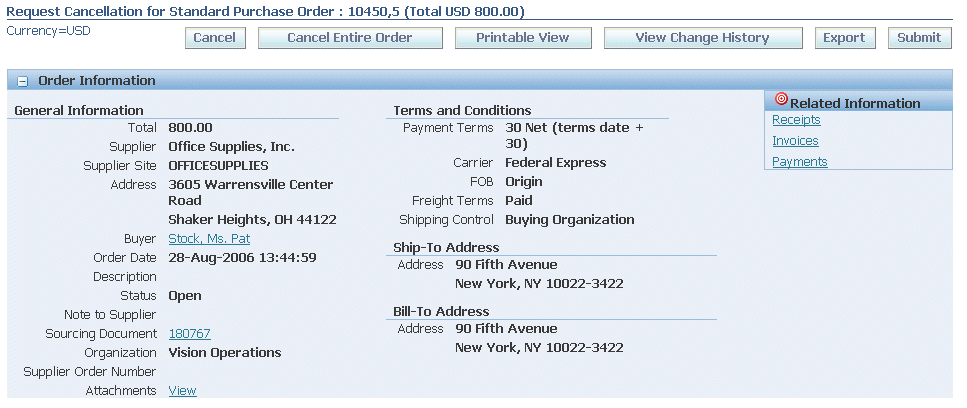
Canceling an order by a buyer or supplier
If a buyer or supplier cancels a shipment and enters a reason for the cancellation, then the Reason column is populated in the Shipments table in the Order Details page. If a shipment is cancelled by a buyer or a supplier, the status of such a shipment is Cancelled.
Managing Deliverables
If your buying company has implemented Oracle Procurement Contracts, you may have deliverables assigned to you. Deliverables include both repository deliverables and purchase order deliverables. Deliverables are also tasks to be completed in order to achieve a certain outcome or business objective, and may be used to track projects for compliance reasons and risk reduction.
For example, your buyer may ask that you send a monthly status report detailing the status of a certain shipment. In this case, your buyer will create a deliverable called "Send Status Report," and assign the deliverable to you. You will see the "Send Status Report" deliverable in the notifications section of the iSupplier Portal home page, and can manage the deliverable from there, or through the View Order Details page. You may attach your status report to the deliverable and change the status of the deliverable.
To manage deliverables
Use the Manage Deliverables page to search for a specific deliverable and update it. To view repository contracts deliverables, select the appropriate contract document type.
To manage deliverables, you can also search for deliverables for a specific purchase order in the Purchase Orders tab.
-
Click the Orders tab, and then click Purchase Orders.
-
Select the PO number of the purchase order that includes deliverables that you want to manage.
-
On the View Order Details page, select Manage Deliverables from the Actions menu, and click Go.
-
On the Deliverables page, click the deliverable that you want to update.
-
Update and add attachments to the deliverable as necessary, and then change its status to Submitted.
-
Click Apply.
You will receive confirmation that your deliverable has been updated. Your buyer will also receive notification that the status of the deliverable has been updated.
Work Orders
Using work orders, buyers and suppliers can monitor outside processing from third parties whose Work In Process (WIP) status and delivery tracking information is critical to their supply chain process flow. Outside processing activities are the activities of the third-party suppliers who provide services needed to complete the final product or maintenance activity.
To view work orders, click the Orders tab, and then click Work Orders in the task bar directly below the tabs. Using the search criteria, you can view details of the orders, schedules, WIP details, operations instructions, components, and component instructions by selecting the links provided. You can also reschedule an order.
Work Orders Page

Agreements
Supplier agreements are purchase agreements you have made with the buying company. On the Supplier Agreements page, you can review the details of those agreements, and the corresponding releases (orders) that have been created for a particular agreement.
To view agreements, click the Orders tab, and then Agreements in the task bar directly below the tabs. Use the search criteria to get a summarized list of agreements. For each agreement, you can select to view the releases created to date for that agreement. You can export details from any page.
Blanket Agreement page
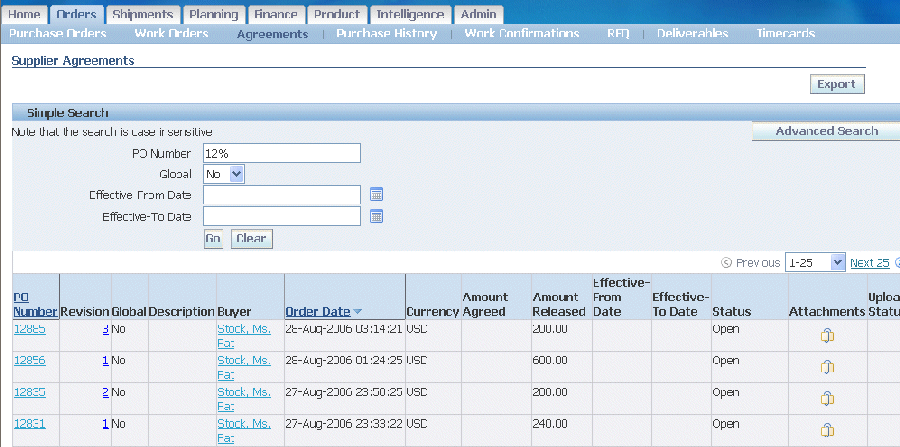
Supplier Brokers have access to information about multiple suppliers, therefore a search filter for transaction documents is enabled for all supplier broker logins. This allows supplier brokers to search for, and filter required data only.
If you have logged in as a supplier broker, this page displays the Supplier dropdown and Supplier Site field. Select a Supplier from the dropdown, this is a mandatory field. The Supplier Site field is optional.
Blanket Purchase Agreements
External descriptors that are associated to the Job – Purchasing Category – Shopping Category combination are displayed along with the job/item related details. You can see the external descriptors in the line details page. Internal descriptors are not seen by suppliers at all, they are visible to buyers only. Suppliers cannot access, download, or edit internal descriptors. Descriptors are external by default, unless they are defined as Internal.
The Linked Attributes column in the PO Details region has a Linked Attributes hyperlink. If you click the hyperlink, a popup displays, showing you the attributes associated to the Job - Purchasing Category - Shopping Category combination.
Editing Agreements
Buying organizations can provide suppliers with the ability to author their own content online, either via bulk file upload or on-line authoring. The industry standard formats supported in the upload mode include OAG XML, cXML, CIF and text file. Suppliers can upload and modify their catalog and buyers only need to approve the upload or change requests. Content provided by the supplier is subject to the buyer's approval before it is made available to the requesters.
To edit catalog information:
-
Access the blanket purchase agreement.
-
On the Blanket Purchase Agreement page, click the purchase number link in the header.
-
On the View Order Details page, select Edit Agreement from the Actions menu, then the Go button, you will be brought to the catalog authoring page and start creating or modifying a catalog.
Update Agreement page
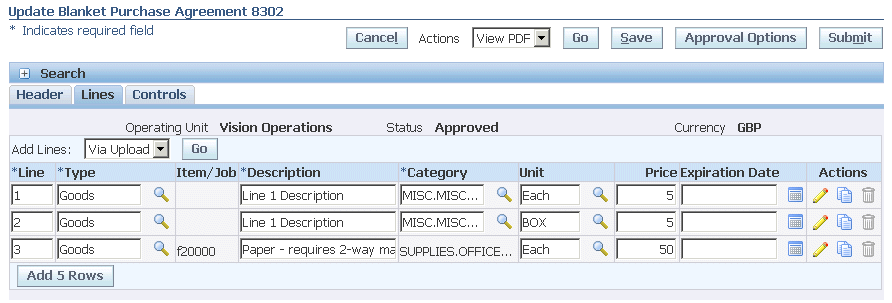
-
After you submit the change, the buyer will receive a notification. The buyer can now approve the change through a notification or through the pending change page.
Downloading Blanket Agreement Lines
You can download agreement lines along with base and user defined descriptors in the format expected by Upload Catalog process. Use the following steps:
-
As a buyer, create a Global Blanket Purchase Agreement and enable Supplier Authoring in the agreement.
-
Login as supplier and search for the agreement.
-
Click the Edit Agreement icon in the search results.
-
Click Download Lines, this will run a concurrent program and the concurrent request ID shows in the page.
-
Click the View Requests link, the request details will show. Click View Output, and save the output file.
Note: Internal Descriptors cannot be downloaded. When suppliers upload agreement lines, the internal descriptors are unaffected by suppliers.
Purchase Order Revision History
The PO Revision History page enables you to search for details on the revision history of a purchase order.
If Oracle Services Procurement is licensed and implemented, users can see changes to the Linked Schedules and Payment terms, which includes Advance and Retention for the lines for which Enable Schedules check box is selected. The Enable Schedules check box is available for a complex PO in Oracle Purchasing Buyer Work Center. For more information, refer to the Entering Purchase Order topic in the Oracle Purchasing User's Guide.
You can see changes to the Linked Attributes (Descriptors) for Rate based Temp Labor lines in the Purchase Order Revision History page. If there are any changes made to the descriptors associated to a Job – Purchasing Category – Shopping Category combination, the system shows the changes to the attributes in this page. Note that any changes to the descriptor value results in the purchase order revision number being incremented.
Using the search criteria, you can get a summarized list of purchase orders that have been revised. You may choose to compare each revised PO to the original PO, the previous PO, or last signed PO (if the revised PO has been signed). You can also view all changes made to the PO.
-
From the iSupplier Portal Home page, click the Orders tab, then click the Purchase History subtab.
-
Enter search criteria to identify the purchase order(s) you wish to inspect. Click Go.
Supplier Brokers have access to information about multiple suppliers, therefore a search filter for transaction documents is enabled for all supplier broker logins. This allows supplier brokers to search for, and filter required data only.
If you have logged in as a supplier broker, this page displays Supplier dropdown, and the Supplier Site dropdown. Select a Supplier from the dropdown, this is a mandatory field. The Supplier Site dropdown is optional. This enables you to search for specific supplier information.
Purchase Order Change History Page


-
From the PO Revision History page, for any particular version, you can compare it to its previous version, compare it to the original purchase order, or you can generate a detailed listing of all changes to the purchase order.
Requests For Quotes (RFQ)
Viewing requests for quotes (RFQs) enables you to select possible negotiations to participate in with the buying company.
To view RFQs, click the Orders tab, and then click RFQ in the task bar directly below the tabs. Enter search criteria in the search fields and click Go. The RFQ Summary page provides the details of all RFQs created by the buying company in its ERP application. Click any of the links on the RFQ Summary page to get more details about the RFQ.
RFQ Summary Results Page

Viewing Time Cards
To be paid for services rendered, contractors can record hours worked using timecards. You may access these time cards if the Timecards task appears under the Orders Tab. You will be able to view timecard information and check the amount of time confirmed by the hiring manager.
To view timecards, click the Orders tab, and then click Timecards in the task bar directly below the tabs. Use the search criteria to get a summarized list of timecards. Click View Timecard to get more details about the timecard. You can export details from any page.